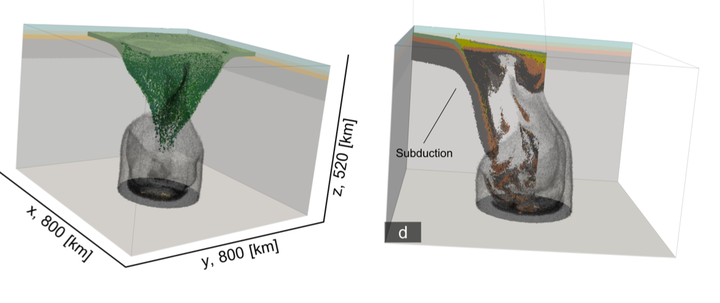Plume-lithosphere interactions during the Archean and implications for the generation of early continental terranes
 3D simulation of plume-lithosphere interaction, highlighting the role of magmatism in the early Earth.
3D simulation of plume-lithosphere interaction, highlighting the role of magmatism in the early Earth.
Abstract
Many Archean terranes are interpreted to have a tectonic and metamorphic evolutions that indicates an intra-crustal reorganization driven by lithospheric- scale gravitational instabilities. These processes are associated with the production of a significant amount of felsic and mafic crust, and they are widely regarded as a consequence of plume-lithosphere interactions. The juvenile Archean felsic crust is made predominantly of rocks of the tonalite-trondhjemite-granodiorite (TTG) suite, which are the result of partial melting of hydrous metabasalts. The geodynamic processes that have assisted the production of juvenile felsic crust, are still not well understood. Moreover, it is still unclear how their evolution can affect the petrogenesis of TTGs. Here, we perform 2D and 3D numerical simulations to study the tectonic evolution of a primitive Archean oceanic plateau in order to understand how the pressure and temperature conditions of both mafic and felsic melts evolve with time. Aiming at doing that, we study the effects of a plume interacting with the lithosphere with different upper mantle potential temperatures (TP ). In our numerical simulations the continuous emplacement of new mafic dry intrusions and the extraction of the felsic melts, generate an unstable lower crust which drips soon after the plume arrival. The gravitational instabilities promotes mantle cooling, and mixing between plume, crustal and asthenospheric material. Moreover, they limit the crustal thickness of the oceanic plateau promoting the generation of felsic melts at low to medium pressures. The subsequent tectonic evolution depends on the asthenosphere TP . If the TP is high enough (≥ 1500 ◦C) the entire oceanic crust is recycled within 2 Myrs. By contrast at low TP the thin oceanic plateau slowly propagates generating plate-boundary like features.